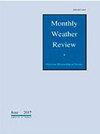Climatological aspects of notable tornado events in Chile
IF 2.8
3区 地球科学
Q3 METEOROLOGY & ATMOSPHERIC SCIENCES
引用次数: 0
Abstract
Tornadoes in Chile seem to develop in what are called “high-shear, low-CAPE” (HSLC) environments. An analysis of convective parameters from the ERA5 reanalysis during sixteen notable tornadoes in Chile showed that several increased markedly before the time of the reports. The significant tornado parameter (STP) was able to discriminate the timing and location of the tornadoes, even though it was not created with that goal. We established thresholds for the Severe Hazards in Environments with Reduced Buoyancy (SHERBE) parameter (≥1) and the STP (≤−0.3) to further identify days favorable for tornado activity in Chile. The SHERBE and STP parameters were then used to conduct a climatological analysis from 1959–2021 of the seasonal, interannual, and latitudinal variation of the environments that might favor tornadoes. Both parameters were found to have a strong annual cycle. The largest magnitudes of STP were found to be generally confined to south-central Chile, in agreement with the (sparse) tornado record. The probability of a day with both SHERBE and STP values beyond their thresholds was greatest between May and August, which aligns with the months with the most tornado reports. The number of days with both SHERBE and STP beyond their respective thresholds was found to fluctuate interanually. This result warrants further study given the known interannual variability of synoptic and mesoscale weather in Chile. The results of this study extend our understanding of tornado environments in Chile and provide insight into their spatio-temporal variability.智利著名龙卷风事件的气候学方面
智利的龙卷风似乎是在所谓的 "高切变、低CAPE"(HSLC)环境中形成的。对ERA5再分析在智利发生的16次著名龙卷风期间的对流参数进行的分析表明,有几次龙卷风的对流参数在报告时间之前明显增加。重要龙卷风参数(STP)能够区分龙卷风发生的时间和地点,尽管它并不是以此为目标而创建的。我们为减少浮力环境中的严重危害(SHERBE)参数(≥1)和 STP 参数(≤-0.3)设定了阈值,以进一步确定有利于智利龙卷风活动的日子。然后,利用 SHERBE 和 STP 参数对 1959-2021 年期间可能有利于龙卷风的环境的季节、年际和纬度变化进行气候学分析。结果发现,这两个参数都有很强的年周期性。最大的 STP 值一般局限于智利中南部,这与龙卷风记录(稀少)一致。SHERBE 和 STP 值均超过临界值的概率在 5 月和 8 月之间最大,这与龙卷风报告最多的月份一致。研究发现,SHERBE 和 STP 值均超出各自阈值的天数每年都有波动。考虑到智利同步和中尺度天气的已知年际变化,这一结果值得进一步研究。这项研究的结果扩展了我们对智利龙卷风环境的了解,并使我们对龙卷风的时空变化有了更深入的认识。
本文章由计算机程序翻译,如有差异,请以英文原文为准。
求助全文
约1分钟内获得全文
求助全文
来源期刊

Monthly Weather Review
地学-气象与大气科学
CiteScore
6.40
自引率
12.50%
发文量
186
审稿时长
3-6 weeks
期刊介绍:
Monthly Weather Review (MWR) (ISSN: 0027-0644; eISSN: 1520-0493) publishes research relevant to the analysis and prediction of observed atmospheric circulations and physics, including technique development, data assimilation, model validation, and relevant case studies. This research includes numerical and data assimilation techniques that apply to the atmosphere and/or ocean environments. MWR also addresses phenomena having seasonal and subseasonal time scales.
文献相关原料
| 公司名称 | 产品信息 | 采购帮参考价格 |
|---|
 求助内容:
求助内容: 应助结果提醒方式:
应助结果提醒方式:


